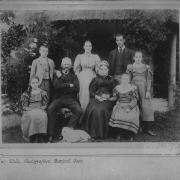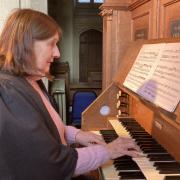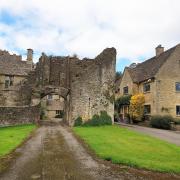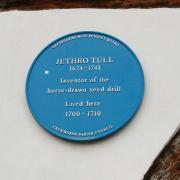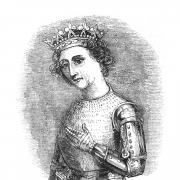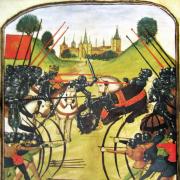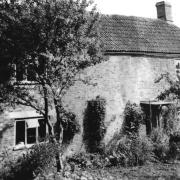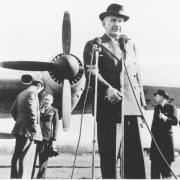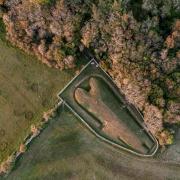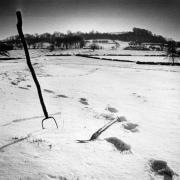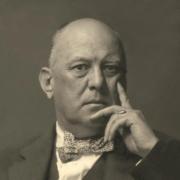The team at Gloucestershire Archives dust off the documents
Photograph of the Month
These images show the Willows No.2 non-rigid airship at Cheltenham’s Montpellier Gardens on July 11, 1910, just before it took off to return to Cardiff. The machine was built by Mr Ernest Willows (1886–1926), a pioneer Welsh aviator who was the first person to hold a private airship pilot’s licence. He is sitting in the ‘car’ bottom left and standing in the centre of the bottom right image. Willows had flown to Cheltenham from Cardiff on July 9 in just four hours, on the new airship’s second proving flight. Willows No.2 was 26.2 m (86 ft) long and 6.7 m (22 ft) in diameter with an 820 m³ (29,000 cubic feet) gas bag made from silk. It was powered by a J.A.P. 30-hp air-cooled motorcycle engine and the pilot sat in a bamboo and steel control car suspended below the hydrogen filled gasbag. Steering was done via a rudder and two swivelling propellers on either side of the car. The following month Willows flew to London, a 122-mile (196 km) flight that took 10 hours – a record for a cross-country flight in Britain at the time. It also made Willows the first aviator to cross the Bristol Channel in a powered aircraft.

Spotlight on Maps
Browse early Ordnance Survey maps and you’ll often spot sites marked as ‘Castle (Site of)’ with an adjacent ‘Moat’. These typically mark the remains of ‘motte & bailey’ castles, and this is one at Winstone Hill, Miserden. This castle was in existence by 1100, sited on a rocky promontory on a meander in the River Frome, overlooking and controlling a ford on the river. Miserden was originally called Greenhampstead, but its name changed thanks to the Norman family who built the castle, the Le Musards. The first lord was Hascoit Le Musard, and his family retained ownership until the early 1300s – the one hiccup being in 1146, when Robert Musard, who supported King Stephen, was captured by Robert of Gloucester, and forced to surrender the castle to Queen Matilda. It was returned but by 1289 it was abandoned in favour of a new manor house to the west, by which time Greenhampstead had become ‘Musardene’ and later Miserden. The castle was partially excavated in 1915 and is now a scheduled monument as it has potential for nationally important undisturbed archaeological deposits relating to its construction and its military and political significance.

Document of the Month
In an era where many new viruses have emerged, e.g., SARS, HIV, MER-coV, etc., and with Covid-19 still looming large, the Buckland parish register for July 1551 records an outbreak of a much earlier deadly epidemic. The ‘Sweating Sickness’, as it was known, claimed the lives of five villagers: George Holeirs, William Parrie, Richard Warckman, Robert Haie and William Goddarde. Also called the English Sweat, this was a mysterious, contagious disease that could cause death within hours. The first symptoms were chills and tremors, followed by fever, pain and profuse sweating. After 24 hours those infected were either dead or recovering. Mortality rates were between 30%-50% but oddly it didn’t strike the young or old but mostly the middle-aged, especially wealthy, upper-class males. There were five epidemics in England between 1485 and 1551 with one reaching mainland Europe. Its cause is a mystery, and no known modern disease matches the symptoms. Modern research suggests the disease vector was linked to climate (outbreaks were always in summer and usually preceded by prolonged rainfall and often flooding) hinting at a mosquito, tick, rodent or bat-borne disease. Current opinion is that a medieval ancestor of the hantavirus pulmonary syndrome is the most likely agent, although an unknown virus or even an anthrax variant are other suspects.

Gloucestershire Character
With a magnificent moustache and mutton-chops, this is Mr Jeremiah Greenaway, photographed on the occasion of his retirement in May 1900. He’d worked for the Great Western Railway for around 40 years, having been Stationmaster of Kemble Station (then known as Kemble Junction Station) for 31 years. Born in Dodington in 1834, he had joined the GWR by the age of 22 and worked as a railway policeman – a term then used for a signalman. He lived in Cirencester but may have been assigned to Fairford Station for on January 3, 1857 he married Charlotte Lewis at Fairford Church. He was then transferred to Bedminster but by 1861 had returned to Cirencester as a goods booking porter. In 1869 he was appointed the Stationmaster at Kemble and this remained his main role until 1890 when he was promoted to Station Inspector. At Kemble he was noted for his pride in maintaining well-kept flower beds at the station and on several occasions, he won GWR prizes for these. He died at his home in Cirencester on February 29, 1912 and was buried in the town cemetery.
Gloucestershire Archives, Clarence Row, Alvin Street, Gloucester, GL1 3DW, gloucestershire.gov.uk/archives




